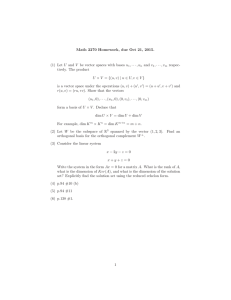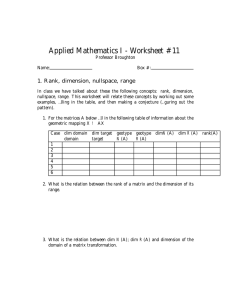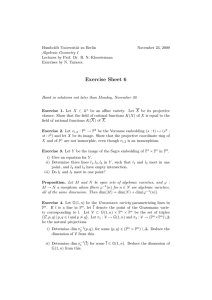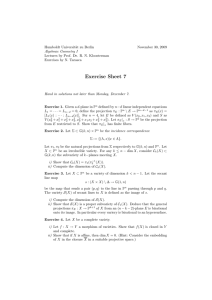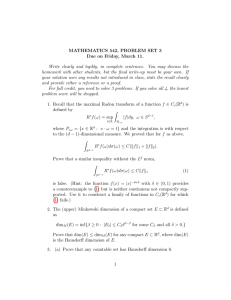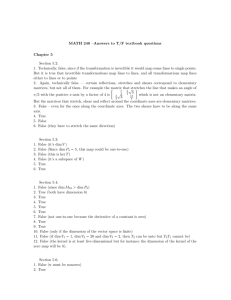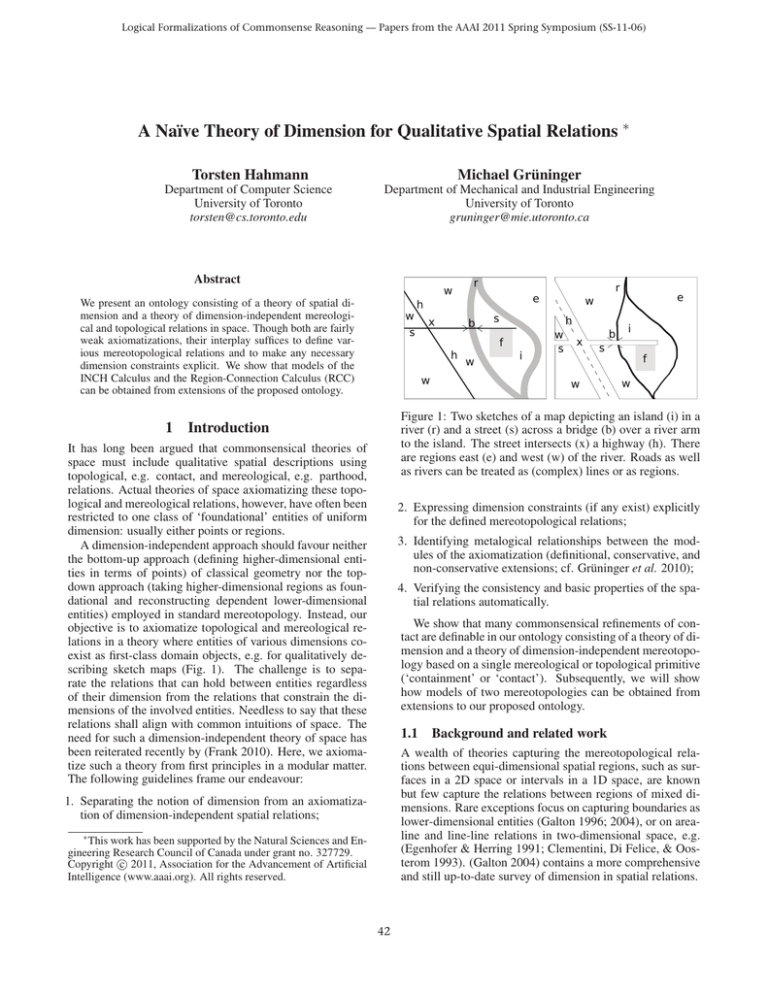
Logical Formalizations of Commonsense Reasoning — Papers from the AAAI 2011 Spring Symposium (SS-11-06)
A Naïve Theory of Dimension for Qualitative Spatial Relations ∗
Torsten Hahmann
Michael Grüninger
Department of Computer Science
University of Toronto
torsten@cs.toronto.edu
Department of Mechanical and Industrial Engineering
University of Toronto
gruninger@mie.utoronto.ca
Abstract
We present an ontology consisting of a theory of spatial dimension and a theory of dimension-independent mereological and topological relations in space. Though both are fairly
weak axiomatizations, their interplay suffices to define various mereotopological relations and to make any necessary
dimension constraints explicit. We show that models of the
INCH Calculus and the Region-Connection Calculus (RCC)
can be obtained from extensions of the proposed ontology.
1
Figure 1: Two sketches of a map depicting an island (i) in a
river (r) and a street (s) across a bridge (b) over a river arm
to the island. The street intersects (x) a highway (h). There
are regions east (e) and west (w) of the river. Roads as well
as rivers can be treated as (complex) lines or as regions.
Introduction
It has long been argued that commonsensical theories of
space must include qualitative spatial descriptions using
topological, e.g. contact, and mereological, e.g. parthood,
relations. Actual theories of space axiomatizing these topological and mereological relations, however, have often been
restricted to one class of ‘foundational’ entities of uniform
dimension: usually either points or regions.
A dimension-independent approach should favour neither
the bottom-up approach (defining higher-dimensional entities in terms of points) of classical geometry nor the topdown approach (taking higher-dimensional regions as foundational and reconstructing dependent lower-dimensional
entities) employed in standard mereotopology. Instead, our
objective is to axiomatize topological and mereological relations in a theory where entities of various dimensions coexist as first-class domain objects, e.g. for qualitatively describing sketch maps (Fig. 1). The challenge is to separate the relations that can hold between entities regardless
of their dimension from the relations that constrain the dimensions of the involved entities. Needless to say that these
relations shall align with common intuitions of space. The
need for such a dimension-independent theory of space has
been reiterated recently by (Frank 2010). Here, we axiomatize such a theory from first principles in a modular matter.
The following guidelines frame our endeavour:
2. Expressing dimension constraints (if any exist) explicitly
for the defined mereotopological relations;
3. Identifying metalogical relationships between the modules of the axiomatization (definitional, conservative, and
non-conservative extensions; cf. Grüninger et al. 2010);
4. Verifying the consistency and basic properties of the spatial relations automatically.
We show that many commonsensical refinements of contact are definable in our ontology consisting of a theory of dimension and a theory of dimension-independent mereotopology based on a single mereological or topological primitive
(‘containment’ or ‘contact’). Subsequently, we will show
how models of two mereotopologies can be obtained from
extensions to our proposed ontology.
1.1
Background and related work
A wealth of theories capturing the mereotopological relations between equi-dimensional spatial regions, such as surfaces in a 2D space or intervals in a 1D space, are known
but few capture the relations between regions of mixed dimensions. Rare exceptions focus on capturing boundaries as
lower-dimensional entities (Galton 1996; 2004), or on arealine and line-line relations in two-dimensional space, e.g.
(Egenhofer & Herring 1991; Clementini, Di Felice, & Oosterom 1993). (Galton 2004) contains a more comprehensive
and still up-to-date survey of dimension in spatial relations.
1. Separating the notion of dimension from an axiomatization of dimension-independent spatial relations;
∗ This work has been supported by the Natural Sciences and Engineering Research Council of Canada under grant no. 327729.
c 2011, Association for the Advancement of Artificial
Copyright Intelligence (www.aaai.org). All rights reserved.
42
Two main approaches towards a theory of topological and
mereological relations are known, namely the logical approach (e.g. the RCC: Cohn et al. 1997) and the intersection approach (Egenhofer 1991; Egenhofer & Herring 1991)
classifying topological relations by the intersection of interiors, boundaries and exteriors. Egenhofer & Herring (1991),
Clementini, Di Felice, & Oosterom (1993), and McKenney
et al. (2005) refined those to a total of 68, 52, and 128,
respectively, topological relations that account for the dimension of the overlap/contact between any combinations of
simple points, lines, and areas. Amongst these relations, the
authors of those three proposals distinguish alone 33 (18, 61)
relations amongst simple lines in a two-dimensional space.
While these approaches are precise in distinguishing a variety of mereotopological configurations, humans are incapable of dealing with such a large set of relations. Moreover,
these relations only apply to spatial entities in 2D space, i.e.
only points, lines and surfaces are considered. The alternative calculus-based approach in Clementini et al. (1993)
on the other hand deals with a small set of commonsensical
relations, but is very ad-hoc and relies on an involved topological apparatus. Moreover, neither of those approaches
enables us to explicitly reason about dimension.
With respect to the calculus-based (or ‘logical’) approaches, our work is most closely related to the INCH Calculus (Gotts 1996) which uses a primitive INCH(x, y) with
the intended meaning ‘x includes a chunk of y’ (a chunk
being an equi-dimensional part). This theory is capable of
describing strong contact (what we call partial overlap and
incidence) but is incapable of capturing superficial contact,
e.g. when two equi-dimensional regions share a boundary or
touch in a point. Nevertheless our axiomatization has been
inspired by that of (Gotts 1996) – we generalize and organize it into a modular set of ontologies. However, we start
with a dimension-independent mereological primitive, containment, and the definition of its dimension-independent
topological counterpart, contact, and then show how other
dimension-dependent mereotopological predicates, such as
INCH, are definable. Thereby, we make the dimension constraints of various mereotopological relations explicit.
Other related calculus-based approaches include the extension of classical mereotopology with dimensions by (Galton 1996) and (Galton 2004). Both are chiefly concerned
with the definability of dependent lower-dimensional entities, in particular boundaries, in a top-down approach to
mereotopology. Galton (1996) shows how such lower-dimensional entities can be accommodated through a set of
equivalence classes that only contain entities of the same dimension while restricting parthood to members of the same
equivalence class. Similarly, (Galton 2004) defines dependent lower-dimensional entities as regular closed subsets of
the boundaries of higher-dimensional entities.
1.2
ables range over ‘spatial entities’, also called ‘regions’ and
referred to as ‘extents’ by (Gotts 1996). We assume that each
spatial entity can be assigned a unique dimension which is
uniform across all parts1 . In particular, a region and the set
of all points contained in the region differ.
Sentences are labelled according to the schema ‘[theory][type][number]’; the type distinguishes axioms (A), definitions (D), theorems (T), extensions (E), and mappings (M).
The consistency of the various theories has been checked
with Mace4 and all theorems have been verified using the
automated theorem prover (ATP) Prover9 (McCune 2010)2 .
2
A naïve theory of dimension
Various notions of dimension have been employed within
theories of qualitative space. We want to axiomatize dimension in the weakest possible way which is still suitable for
defining spatial relations that are limited to entities of certain
(relative) dimensions. For example we want to be able to express that region A has a higher dimension than region B or
the intersection of regions A and B has a lower dimension
than either one. Thereby it is unnecessarily restrictive to e.g.
require that dimensions can be added or subtracted or restrict
the total number of distinct dimensions. In other words, the
sought axiomatization should be just strong enough to allow
us to compare the dimensions of spatial entities.
A brief look at the various definitions of dimension in
topology can be of help. There we find the small and large
inductive dimensions, the Lebesgue covering dimension (cf.
McKenney et al. 2005), the Haussdorff dimension, and the
notion of dimension in the theory of manifolds. (Engelking
1995) gives a good overview of dimension from the topological perspective. Other notions of dimensions, e.g. those
used for vector spaces or Hilbert spaces, are difficult to include in a qualitative theory of space.
A theory of dimension that suits our needs can be constructed reusing core ideas from inductive definitions of dimension. However, the relevant topological definitions are
either still overly restrictive or rely on a heavy topological
apparatus of which we would like to rid ourselves. We construct our basic theory of dimension, Tdim , as weak axiomatizations of the binary primitive relations < and =dim . Their
intended interpretations are ‘x has a lower dimension than
y’ (x < y) and ‘x and y have the same dimension’ (x =dim y).
< is irreflexive, asymmetric, and transitive (strict partial order). =dim meanwhile is reflexive, symmetric, and transitive
(equivalence relation). Though in many settings one would
define =dim in terms of < as x =dim y ↔ x ≮ y ∧ y ≮ x, this is
not required in Tdim . We thereby permit incomplete information regarding the dimension of entities, i.e. models in which
neither x =dim y, nor, x < y, nor y < x hold. D-A7 to D-A9
govern the relationship between < and =dim while D-A11,
D-A12 ensure that a potential zero region (we use ZEX from
(Gotts 1996)) is unique and of lowest dimension. D-A10 demands a lowest-dimensional entity (apart from ZEX) without preventing infinite-dimensional models. As this paper
Preliminaries
Our axiomatization uses standard unsorted first-order logic
with equality where ¬, ∧, ∨, →, ↔ denote the connectives of
negation, and, or, implication, and ‘if and only if’, respectively. Variables appearing free in sentences are assumed to
be universally quantified unless otherwise stated. All vari-
1 Containment is the dimension-independent version of ‘parthood’ that can express that, e.g., an object contains a crack.
2 Available at www.cs.toronto.edu/~torsten/DCT
43
will show, this theory is sufficiently strong to distinguish
mereotopological relations that depend on dimensions.
(D-D6)
(D-T1)
(D-T2)
(D-T3)
(D-T4)
(D-T5)
Figure 2: Modules of the theory of dimension.
can require regions to be dimensionally comparable (D-E4).
Such theory of linear dimension Tdim−linear extends Tdim
non-conservatively; it entails x =dim y ↔ x ≷ y and D-E3.
(D-E1) ∃x(Atom(x) ∧ ∀y(Atom(y) → x =dim y))
(D-E2) ∃x(MaxDim(x) ∧ ∀y(MaxDim(y) ↔ x =dim y))
(unique minimum and maximum dimensions)
(D-E3) ¬ZEX(x) ∧ MaxDim(y) ∧ Atom(y) → y =dim x
(equi-dimensionality if maximum = minimum dimension)
(comparability required)
(D-E4) x < y ∨ y < x ∨ x =dim y
(existence of a ZEX)
(no ZEX exists)
Further extensions can limit the number of distinct dimensions to any other particular number (cf. Fig. 2) as necessary
for e.g. k-partite incidence geometry.
Now we introduce additional useful definitions for dimension. The module Tdim−de f s = Tdim ∪ {D-D1–D-D6} is a
(conservative) definitional extension of Tdim . D-D6 requires
some explanation: it makes the distinction between x =dim y
and x ≮ y ∧ y ≮ x explicit. We allow models in which dimensionally incomparable regions have ‘possibly the same
dimension’. This can be useful when the dimension of an
entity differs depending on the relation to other entities. A
building, e.g., can be 2D in relation to the street it is located on, but 3D when related to its floors which themselves
might be 2D on a floor plan, but 3D when talking about storage space. Entities of minimal or maximal dimension as
defined by D-D4 and D-D5 are thus not necessarily of minimum or maximum dimension because e.g. two maximaldimensional entities might be incomparable with respect to
their dimensions. In Tdim−de f s basic properties of ≷ and of
its interaction with < and =dim are provable (D-T1 to D-T5).
(D-D1)
(D-D2)
(D-D3)
(D-D4)
(D-D5)
While Tdim = {D-A1–D-A12} is agnostic about the existence of a zero region to accommodate extensions in which
such region is either desirable or convenient, its extensions
0 and by NZ-A1 force/prevent a zero region.
by Z-A1 to Tdim
(Z-A1) ∃xZEX(x)
(NZ-A1) ¬ZEX(x)
(D-A1) x ≮ x
(< irreflexive)
(D-A2) x < y → y ≮ x
(< asymmetric)
(D-A3) x < y ∧ y < z → x < z
(< transitive)
(=dim reflexive)
(D-A4) x =dim x
(=dim symmetric)
(D-A5) x =dim y → y =dim x
(=dim transitive)
(D-A6) x =dim y ∧ y =dim z → x =dim z
(=dim and < incompatible)
(D-A7) x < y → ¬x =dim y
(=dim renders < transitive)
(D-A8) x =dim y ∧ z < x → z < y
(=dim renders < transitive)
(D-A9) x =dim y ∧ x < z → y < z
(D-A10) ∃x(¬ZEX(x) ∧ ∀y(y < x → ZEX(y)))
(lowest dim.)
(D-A11) ZEX(x) ∧ ZEX(y) → x = y
(unique ZEX)
(D-A12) ZEX(x) ∧ ¬ZEX(y) → x < y (ZEX has minimal dim.)
3
Dimension-independent spatial relations
We proceed by examining the mereological and topological relations that can hold between spatial entities independent of their dimension. On the mereological side this is
spatial containment, denoted by Cont(x, y), and on the topological side it is contact, denoted by C(x, y). Though we
choose Cont as spatial primitive, C would serve equally well
as primitive which can define Cont. This interchangeability of a topological and mereological primitive has first been
observed in (Hahmann, Winter, & Grüninger 2009) for the
equi-dimensional mereotopology of (Asher & Vieu 1995).
3.1
Containment as mereological relation
What parthood is to equi-dimensional mereotopology, containment is to dimension-independent mereotopology. In its
point-set interpretation, we say ‘y contains x’, i.e. Cont(x, y),
if every point in space occupied by x is also occupied by y.
A region can contain not only a (smaller) region of the same
dimension (equi-dimensional parthood), but also a lower-dimensional entity. E.g. a 2D-surface can contain another 2Dsurface, a line, or a point. Containment is a non-strict partial
order. We again use ZEX to denote a zero region which
neither contains nor is contained in any other region. For
the basic theory of containment, Tcont = {C-A1–C-A4} we
make no assumption about the (non-)existence of a zero re0 =T
gion. Two extensions are feasible: Tcont
cont ∪ {Z-A1}
¬0
and Tcont = Tcont ∪ {NZ-A1}.
x>y↔x<y
(greater dim.)
(lesser or equal dim.)
x ≤ y ↔ x < y ∨ x =dim y
(greater or equal dim.)
x ≥ y ↔ x > y ∨ x =dim y
MaxDim(x) ↔ ∀y(x ≮ y) (maximal-dimensional entity)
Atom(x) ↔ ¬ZEX(x) ∧ ∀y(y < x → ZEX(y))
(atom = minimal-dimensional entity apart from ZEX)
x ≷ y ↔ x ≮ y ∧ y ≮ x
(possibly equal dimension)
x ≷ x
(
≷ reflexive)
x ≷ y → y ≷ x
(
≷ symmetric)
(
≷ transitive under =dim )
x =dim y ∧ y ≷ z → x ≷ z
(=dim implies ≷)
x =dim y → x ≷ y
x < y → x =dim z ∨ y =dim z
Two further extensions are of practical importance. First,
the theory of bounded dimension Tdim−bounded , which nonconservatively extends Tdim by D-E1 to D-E3 ensuring that
unique minimum and maximum dimensions exist while
coincidence of maximum and minimum dimension forces
equi-dimensionality of a model. Independently thereof, we
(C-A1)
(C-A2)
(C-A3)
(C-A4)
44
¬ZEX(x) → Cont(x, x)
(Cont reflexive)
Cont(x, y) ∧Cont(y, x) → x = y
(Cont antisymmetric)
Cont(x, y) ∧Cont(y, z) → Cont(x, z)
(Cont transitive)
ZEX(x) → ∀y(¬Cont(x, y) ∧ ¬Cont(y, x))
(no entity contains or is contained in ZEX)
weak (or superficial) contact. We show that the three form
an exhaustive and pairwise disjoint set of contact relations.
First, notice that the traditional notion of parthood, i.e.
containment between two equi-dimensional entities, is easily defined in Tcont−dim . We verify that parthood is a nonstrict partial order (P-T1 to P-T3) which implies contact
(P-T8) and we prove simple transitivity properties in interaction with dimension constraints (P-T4 to P-T7).
Figure 3: Modules of the theory of containment.
3.2
Contact as a definable topological relation
(P-D) P(x, y) ↔ Cont(x, y) ∧ x =dim y
(parthood)
(P-T1) ¬ZEX(x) → P(x, x)
(P reflexive)
(P-T2) P(x, y) ∧ P(y, x) → x = y
(P antisymmetric)
(P-T3) P(x, y) ∧ P(y, z) → P(x, z)
(P transitive)
(P-T4) P(x, y) ∧ z < x → z < y
(P-T5) P(x, y) ∧ y < z → x < z
(P-T6) P(x, y) ∧ z =dim x → z =dim y
(P-T7) P(x, y) ∧ z =dim y → x =dim z
(P-T8) P(x, y) → C(x, y)
(parthood requires contact)
Now contact C is definable in terms of containment (C-D).
Those familiar with equi-dimensional mereotopology might
notice the close resemblance to the common mereotopological definition of overlap as O(x, y) ↔ ∃z(P(z, x) ∧ P(z, y)).
We can subsequently prove that C is reflexive and symmetric and does not hold for the zero-region. We can also show
monotonicity of C (C-T4) in case of containment. The inverse of C-T4 is not entailed and thus posited as axiom
C-A5. Hence Tcont−c = Tcont ∪ {C-D, C-A5} is a non-conservative extension of Tcont . C-T4 and C-A5 imply that Cont
is also definable by contact C as primitive relation.
4.1
(C-D) C(x, y) ↔ ∃z(Cont(z, x) ∧Cont(z, y))
(contact)
(C-T1) ¬ZEX(x) → C(x, x)
(C reflexive)
(C-T2) C(x, y) → C(y, x)
(C symmetric)
(C-T3) ZEX(x) → ∀y(¬C(x, y)) (nothing in contact with ZEX)
(C-T4) Cont(x, y) → ∀z(C(z, x) → C(z, y))
(Cont implies C monotone)
(C-A5) ¬ZEX(x)∧¬ZEX(y)∧∀z(C(z, x) → C(z, y)) → Cont(x, y)
(C monotone implies Cont)
Equi-dimensional: Partial overlap Parthood allows us to
define partial overlap as the strongest contact holding when
two regions share a part. Partial overlap is a reflexive and
symmetric relation requiring equi-dimensionality.
(PO-D) PO(x, y) ↔ ∃z(P(z, x) ∧ P(z, y))
(partial overlap)
(PO-T1) ¬ZEX(x) → PO(x, x)
(PO reflexive)
(PO-T2) PO(x, y) → PO(x, y)
(PO symmetric)
(PO-T3) PO(x, y) → x =dim y (PO requires equi-dimensionality)
As side-effect, C-D forces a mereological closure. Contact between two entities requires the existence of a common
contained entity – interpretable as intersection. A useful and
common assumption is extensionality of C.
(C-E1) x = y ↔ ∀z(C(z, x) ↔ C(z, y))
4
Strong contact
Non-equi-dimensional: Incidence Two entities of different dimension can also be in strong contact. We generalize
partial overlap to incidence by requiring that they share a region that is part of one (instead of both) of them, but do not
share a region that is part of both. The theorems INC-T1 to
INC-T6 become provable.
(C extensional)
Interaction of dimension and containment
(INC-D) Inc(x, y) ↔ ∃z[Cont(z, x) ∧ P(z, y) ∧ z < x] ∨ ∃z[P(z, x) ∧
Cont(z, y) ∧ z < y]
(incidence)
(INC-T1) ¬Inc(x, x)
(Inc irreflexive)
(INC-T2) Inc(x, y) → Inc(y, x)
(Inc symmetric)
(INC-T3) x =dim y → ¬Inc(x, y)
(equi-dimensionality prevents incidence)
(INC-T4) Inc(x, y) → x < y ∨ y < x
(incidence requires comparability of entities)
(INC-T5) Cont(x, y) ∧ x < y → Inc(x, y)
(containment of a lower-dimensional entity requires incidence)
(INC-T6) Inc(x, y) ∧ P(y, z) → Inc(x, z)
(incidence transitive with respect to parthood)
The basic theory of containment, Tcont , can be combined
with Tdim by axiomatizing the direct relation between containment and dimension: if x is contained in y, then x must
have a dimension that is the same as or lower than that of y.
We obtain Tcont−dim = Tcont−c ∪ Tdim ∪ {CD-A1}.
(CD-A1) Cont(x, y) → x < y ∨ x =dim y
Surprisingly, all theorems in this section, with the exception of exhaustiveness of the contact relations (CD-T4), can
be proved without using CD-A1.
Another common assumption is indivisibility of atoms
(cf. CD-E1), the non-zero entities of lowest dimension. Indivisibility is justified as long as atoms represent points. If
the entities of the lowest dimension represent lines or surfaces it is too strong an assumption. Though a necessary
extension e.g. for incidence geometry, we do not include
CD-E1 in our general theory of containment and dimension.
Boundaries (and parts thereof) are special kinds of entities incident with the bounded entity. A naïve definition
(INC-E1) defining boundary parts as lower-dimensional entities that arise when two non-overlapping, non-incident entities meet is far from ideal: e.g. the intersection point of two
crossing lines is part of the boundary of either line. We can
prevent this by excluding from the boundary those ‘parts of
the boundary’ (BP) that are contained in two non-overlapping parts of the bounded entity. We refrain from exploring
these issues further and refer to the abundant literature on
boundaries, e.g. (Fleck 1996; Smith & Varzi 1997).
(CD-E1) Atom(x) → ∀y(Cont(y, x) → x = y) (indivisible atoms)
We use Tcont−dim to define three types of contact that depend on the dimension of the entities in contact and/or the
dimension of the common entity. We distinguish two types
of strong contact, namely partial overlap and incidence, and
(INC-E1) BP(x, y) ↔ Cont(x, y) ∧ Inc(x, y) ∧ ∃z[Cont(x, z) ∧ x < z
∧¬PO(z, y) ∧ ¬Inc(z, y)]
(x is part of the boundary of y)
45
5
Now we show how to extend the ontology T f ull so that the
models of the extension are models of (a) the INCH Calculus (Gotts 1996) or (b) the RCC (Cohn et al. 1997). More
precisely, the INCH Calculus and the RCC faithfully and definably interpret (Grüninger et al. 2010), respectively, ex0 ∪T
tensions of T f0ull−linear = T f ull ∪ Tdim
dim−linear . Recall
that this extended theory requires a zero entity and dimensional comparability of all entities. Our extensions explicitly
formalize previously implicit dimension constraints for various spatial relations such as external contact (EC), includes
an equi-dimensional chunk of (INCH), or lower-dimensional
element (EL).
Figure 4: The mereotopological concepts parthood (and
partial overlap), incidence, and superficial contact are def0
initional extensions of the theories Tcont−dim and Tcont−dim
which combine containment with dimension.
4.2
Relationship to other spatial theories
5.1
INCH Calculus
We first define the intended (or ‘primary’) interpretation, ‘x
includes a chunk (a part) of y’, of the relation INCH(x, y)
in terms of dimension and containment (I-D). The axioms
(I-PA3)–(I-PA7) of the INCH Calculus are immediately
provable in the presence of the definitions I-D1 to I-D5.
Moreover, the defined relations ZEX, GED, ED, and GD in
(Gotts 1996) correspond to our dimension predicates ZEX,
≥, =dim , and >, respectively (I-D6 to I-D9). We define
Tinch−basic = T f0ull−linear ∪ {I-D, I-D1 – I-D9}.
Weak contact: Superficial contact
While partial overlap and incidence are strong contacts in
the sense that the shared entity is at least an equi-dimensional part of one region, superficial contact is a weak contact. We say two entities are in superficial contact, SC, if the
shared spatial entity has a dimension lower than both entities in contact. SC-T1 proves that this is equivalent to saying
that two entities are in superficial contact if they are in contact but the shared entity is not a part of either. Superficial
contact is an irreflexive and symmetric relation.
(I-D) INCH(x, y) ↔ ∃z(Cont(z, x) ∧ P(z, y))
(includes a chunk)
(I-D1) CS(x, y) ↔ ∀z(INCH(x, z) → INCH(y, z))
(‘x is a constituent of y’)
(SC-D) SC(x, y) ↔ ∃z[Cont(z, x) ∧ Cont(z, y)] ∧ ¬∃z[(Cont(z, x) ∧
(superficial contact)
Cont(z, y) ∧ (x =dim z ∨ y =dim z]
(SC-T1) SC(x, y) ↔ C(x, y) ∧ ¬∃z[(Cont(z, x) ∧ P(z, y)] ∧
¬∃z[(P(z, x) ∧Cont(z, y)]
(SC-T2) ¬SC(x, x)
(SC irreflexive)
(SC-T3) SC(x, y) → SC(y, x)
(SC symmetric)
(SC-T4) SC(x, y) → ∃z(z < x ∧ z < y ∧Cont(z, x) ∧Cont(z, y))
(SC requires a shared entity of a lower dimension)
(I-D2) OV (x, y) ↔ INCH(x, y) ∧ INCH(y, x)
(overlap)
(I-D3) CO(x, y) ↔ ∃z(¬ZEX(z) ∧CS(z, x) ∧CS(z, y))
(connection)
(I-D4) CH(x, y) ↔ INCH(x, y) ∧ ∀z(OV (x, z) → OV (y, z))
(‘x is a chunk (equi-dimensional part) of y’)
(I-D5) EL(x, y) ↔ CS(x, y) ∧ ¬INCH(x, y)
(’x is a (lower-dimensional) element of y’)
Superficial contact is dimension-independent. An equidimensional version can only be defined if at least one region
has codimension 0 such as in traditional equi-dimensional
mereotopology where all regions are of the same dimension.
(I-D7) GED(x, y) ↔ y < x ∨ x =dim y
(SC-E1) SC(x, y) ∧ MaxDim(x) → EC(x, y) (external connection)
(I-D9) GD(x, y) ↔ y < x
(I-D6) ZEX(x, y) ↔ ¬INCH(x, y)
(greater or equal dim.)
(I-D8) ED(x, y) ↔ x =dim y
(equal dimension)
(greater dimension)
(I-PA3) INCH(x, y) → INCH(x, x)
4.3
(I-PA4) GED(x, y) ∨ GED(y, x)
Exhaustiveness and disjointness
In the theory T f ull = Tcont−dim ∪ {P-D,PO-D,Inc-D,SC-D},
PO, SC, and Inc are pairwise disjoint (CD-5 to CD-10) and
are an exhaustive set of contact relations (CD-1 to CD-4).
(I-PA5) GED(x, y) ∧ GED(y, z) → GED(x, z)
(I-PA6) INCH(x, y) ∧ INCH(y, z) ∧ INCH(z, x) → INCH(y, x)
(I-PA7) INCH(x, y) → ∃z(CS(z, x) ∧ OV (z, y))
(CD-T1) PO(x, y) → C(x, y)
(CD-T2) SC(x, y) → C(x, y)
(CD-T3) Inc(x, y) → C(x, y)
(CD-T4) C(x, y) → PO(x, y) ∨ SC(x, y) ∨ Inc(x, y)
(CD-T5) PO(x, y) → ¬SC(x, y)
(CD-T6) PO(x, y) → ¬Inc(x, y)
(CD-T7) SC(x, y) → ¬PO(x, y)
(CD-T8) SC(x, y) → ¬Inc(x, y)
(CD-T9) Inc(x, y) → ¬PO(x, y)
(CD-T10) Inc(x, y) → ¬SC(x, y)
Next, we verify that in Tinch−basic , PO is equivalent to OV
and under the premise of y < x, Inc is equivalent to INCH.
Moreover, Cont, C, P, and SC are interpretable using the
defined relations CS, CO, and CH from the INCH Calculus.
(I-M1) Cont(x, y) ∨ ZEX(x) → CS(x, y)
(I-M2) OV (x, y) ↔ PO(x, y)
(I-M3) CO(x, y) → C(x, y)
(I-M4) P(x, y) → CH(x, y)
(I-M5) (Cont(x, y) ∧ x < y) ∨ ZEX(x) → EL(x, y)
46
T f0ull−linear ∪Tdim−bounded . We do not attempt to directly construct models of the RCC, but instead show how we can obtain connected atomless Boolean contact algebras. The representation of RCC models by this class of contact algebras
from (Düntsch & Winter 2005) then allows us to conclude
that equivalent models of the RCC must exist.
(I-M6) y < x → (Inc(x, y) ↔ INCH(x, y))
(I-M7) SC(x, y) → CO(x, y) ∧ ¬INCH(x, y) ∧ ¬INCH(y, x)
Extensionality of INCH (I-PA1, I-PA2) and the Boolean
operations sum and diff (I-PA9, I-PA10) are proper extensions of Tinch−basic , i.e. they are not entailed. Also I-PA8
does not follow, it is e.g. violated by entities of mixed dimensions such as a disk with a spike and needs to be added
to restrict Tinch−basic to the models of the INCH Calculus.
(RCC-D1) NZRegion(x) ↔ MaxDim(x)
(RCC-D2) R(x) ↔ NZRegion(x) ∨ ZEX(x)
(I-PA1) x = y ↔ ∀z(INCH(x, z) ↔ INCH(y, z))
We require binary meets (intersections, RCC-A1) and
joins (sums, RCC-A2) and a universal (RCC-A3) in the set
R resulting in bounded lattices R, RP with RP defining the
partial order. These bounded lattices are Boolean because
of unicomplementation (RCC-A4) and region-extensionality of C (RCC-A5). To obtain connected atomless Boolean
contact algebras it now suffices to ensure connectedness
(complements are in SC; RCC-A6). Then, all non-trivial
models (RCC-A7) are automatically atomless by RCC-T1,
cf. (Düntsch & Winter 2005).
(I-PA8) CH(x, y) → CS(x, y)
(I-PA9) x =dim y → ∃z∀w(INCH(z, w) ↔ INCH(x, w) ∨
INCH(y, w))
(z = sum(x,y))
(I-PA10) x =dim y → ∃z∀w(INCH(z, w) ↔ ∃v[INCH(v, w) ∧
CH(v, x) ∧ ¬OV (v, y)])
(z = diff(x,y))
Now we can formalize the relationship between our the .
ory and the original INCH-calculus, denoted by Tinch
Theorem 1. Let Tinch− f ull = T f0ull−linear ∪ {I-PA1, I-PA2,
={I-PA1 – I-PA10, I-D1 – I-D9}.
I-PA8 – I-PA10} and Tinch
faithfully interprets Tinch− f ull , i.e. every model M
Then Tinch
so that
of Tinch− f ull can be extended to a model M of Tinch
all sentences consistent with M are consistent with M .
The reverse does not hold, i.e. not every model of Tinch
is
also a model of Tinch− f ull . This is due to the failure of the
sentence (the inverse of the implication in I-M1)
(RCC-A1) R(x) ∧ R(y) → ∃m[R(m) ∧ RP(m, x) ∧ RP(m, y) ∧
∀z(RP(z, x) ∧ RP(z, y) ↔ RP(z, m))]
(m = x · y)
(RCC-A2) R(x) ∧ R(y) → ∃ j[R( j) ∧ RP(x, j) ∧ RP(y, j) ∧
( j = x + y)
∀z(RP(x, z) ∧ RP(y, z) ↔ RP( j, z))]
(RCC-A3) R(U) ∧ ∀x(R(x) → RP(x,U))
(universal U)
(RCC-A4) NZRegion(x)∧ZEX(z) → ∃x [NZRegion(x )∧x+x =
U ∧x·x = z∧∀v[(NZRegion(v)∧x+v = U ∧x·v = z) → x = v]]
(x is the unique complement of x)
(I-M1R) CS(x, y) ∧ ¬ZEX(x) → Cont(x, y)
indicating that either: (a) we do not capture all intended
interpretations of INCH or (b) that the axiomatization in
(Gotts 1996) has unintended models. This necessitates a
closer investigation beyond the scope of this paper. However, we do have the following partial result:
Theorem 2. Tinch− f ull ∪ I-M1R entails the sentences
(RCC-A5) R(x)∧R(y) → [x = y ↔ ∀z[R(z) → (C(z, x) ↔ C(z, y))]]
(extensionality of C amongst regions)
(RCC-A6) NZRegion(x) ∧ x = U → SC(x, x )
(RCC-A7) ∃x(NZRegion(x) ∧ X = U)
(RCC-T1) NZRegion(x) → ∃y(x = y ∧ P(y, x))
C(x, y) → CO(x, y)
CH(x, y) → P(x, y)
EL(x, y) ∧ ¬ZEX(x) → Cont(x, y) ∧ x < y
CO(x, y) ∧ ¬INCH(x, y) ∧ ¬INCH(y, x) → SC(x, y)
(connectedness)
(non-trivial)
(inf. divisibility)
0
Theorem 3. Suppose Tdim−eq
= T f0ull−linear ∪ Tdim−bounded ∪
{RCC-D1 – RCC-D3, RCC-A1 – RCC-A7}.
0
For any model M of Tdim−eq
there exists a model N of
RCC such that N is definably interpreted in M .
Observe that I-M2 and I-M6 already contain the bidirectional implication and thus do not require additional inverses. Therefore, I-MIR establishes all equivalences between the relations of the INCH-calculus and the relations
definable in our extension Tinch− f ull .
5.2
(regions)
(RCC-D3) RP(x, y) ↔ (P(x, y) ∧ R(x)) ∨ (ZEX(x) ∧ R(y))
(parthood amongst regions)
(I-PA2) x = y ↔ ∀z(INCH(z, x) ↔ INCH(z, y))
(I-M3R)
(I-M4R)
(I-M5R)
(I-M7R)
(non-zero regions)
To prove Theorem 3, recall that a structure N with language L1 is definable in a structure M with language L2
iff there exists a definable set X ⊆ M n and we can interpret the symbols of L1 as definable subsets and functions
on X so that the resulting structure is isomorphic to N
(Grüninger et al. 2010). For the proof of Theorem 3
we choose X = {x|x ∈ NZRegion} as the definable set.
Since we already ensured that X forms a connected atomless Boolean algebra, it remains to show that for all elements
x, y ∈ X, contact C in N is defined as C(x, y) ≡ ¬P(x, y ) (as
in RCC models) exactly when C(x, y) holds in M . This is
guaranteed by the axioms C-D (definition of contact), P-D
(definition of parthood), RCC-A4, RCC-A5, and RCC-A6.
All other relations in the model N are in turn definable in
terms of C (as in RCC). We thus obtain a connected, atomless Boolean contact algebra X, C with the zero element
removed, which is a model of the RCC.
Equi-dimensional mereotopology (RCC)
In order to restrict the theory to models of equi-dimensional mereotopology, we cannot, somewhat counterintuitively, prohibit entities of lower dimensions. Otherwise,
‘external connection’ in the RCC or ‘meet’ in the Interval
Calculus (Allen 1983), both special cases of SC (cf. SC-E1),
have empty extensions according to SC-T4. This reduces
the mereotopology to a pure mereology with overlap as only
contact relation. Instead, we base the mapping to models of
the RCC on the set of non-zero regions: the entities of maximum dimension (RCC-D1) guaranteed to exist by D-E2 in
47
6
Summary and outlook
Cohn, A. G.; Bennett, B.; Gooday, J. M.; and Gotts, N. M.
1997. Representing and reasoning with qualitative spatial
relations about regions. In Stock, O., ed., Spatial and Temporal Reasoning. Kluwer. 97–134.
Düntsch, I., and Winter, M. 2005. A representation theorem
for Boolean contact algebras. Theoretical Computer Science
347:498–512.
Egenhofer, M. J., and Herring, J. 1991. Categorizing binary topological relations between regions, lines, and points
in geographic databases. Technical report, Department of
Surveying Engineering, Univ. of Maine.
Egenhofer, M. J. 1991. Reasoning about binary topological
relations. In Symposium on Spatial Databases (SSD’91),
LNCS 525, 141–160. Springer.
Engelking, R. 1995. Theory of Dimensions: Finite and
Infinite, volume 10 of Sigma Series in Pure Mathematics.
Heldermann.
Fleck, M. M. 1996. The topology of boundaries. Artificial
Intelligence 80:1–27.
Frank, A. U. 2010. How do people think about space. Position paper for Dagstuhl seminar 10131: "Spatial Representation and Reasoning in Language".
Galton, A. 1996. Taking dimension seriously in qualitative spatial reasoning. In European Conference on Artifiical
Intelligence (ECAI-96), 501–505.
Galton, A. 2004. Multidimensional mereotopology. In
KR’04: Principles of Knowledge Representation and Reasoning, 45–54.
Gotts, N. M. 1996. Formalizing commonsense topology: the
INCH calculus. In Int. Symposium on Artificial Intelligence
and Mathematics, 72–75.
Grüninger, M.; Hahmann, T.; Hashemi, A.; and Ong, D.
2010. Ontology verification with repositories. In Conference on Formal Ontology in Information Systems (FOIS-10),
317–330. IOS Press.
Hahmann, T., and Grüninger, M. 2009. Detecting physical
defects: A practical 2D-study of cracks and holes. In AAAISS’09: Benchmarking of Qualitative Spatial and Temporal
Reasoning Systems, 11–16. AAAI Press.
Hahmann, T.; Winter, M.; and Grüninger, M. 2009. Stonian
p-ortholattices: A new approach to the mereotopology RT 0 .
Artificial Intelligence 173:1424–1440.
McCune, W. 2010. Prover9. http://www.cs.unm.edu/ mccune/prover9/.
McKenney, M.; Pauly, A.; Praing, R.; and Schneider, M.
2005. Dimension-refined topological predicates. In Conference on Advances in Geographic Information Systems (GIS05), 240–249. ACM.
Reiter, R., and Mackworth, A. K. 1989. A logical framework
for depiction and image interpretation. Artificial Intelligence
41(2):125–155.
Smith, B., and Varzi, A. 1997. Fiat and bona fide boundaries: Towards and ontology of spatially extended objects.
In Conference on Spatial Information Theory (COSIT-97),
LNCS 1329, 103–119. Springer.
We have presented an ontology that clearly separates properties of dimension from dimension-independent mereotopological primitives (containment and contact). We demonstrated how mereotopological relations, in particular parthood and the various contact relations, become definable
through the rather weak interaction of dimension and containment. The dimension is only used relatively, that is, parthood as well as partial overlap require spatial entities to be
of equal dimension, whereas incidence requires one element
to be of lower dimension and weak contact is only applicable of the shared entity is of a lower dimension. Without
using absolute dimensions (such as a two-dimensional entity), we can provide a jointly exhaustive, pairwise disjoint
categorization of (binary) contact between spatial entities in
terms of partial overlap, incidence, and weak contact.
We verified all discussed modules of the ontology by
proving all theorems mentioned in the paper with an automated theorem prover and by generating non-trivial models for T f ull ∪{D-E1 to D-E4} (T f ull restricted to linear and
bounded dimensions) showing the consistency of the theory. Each non-trivial model ensures that the extensions of
all spatial relations are non-empty. Then all weaker theories
discussed in the paper also have non-trivial models. Moreover, we confirmed that commonsensical descriptions of the
sketches in Fig. 1 are consistent with the ontology. The ontology is applicable in any domain dealing with spatial entities of two or more dimensions. We intend to explore the
following application and refinements in the future.
• Interpret incidence geometry as an extension of our ontology by limiting the number of distinct dimensions.
• Refine superficial contact to capture intuitive notions such
as ‘touches’, ‘borders’, ‘crosses’, and ‘attachment’.
• Explore the reasoning capabilities and limitations of an
extension capturing sketch maps (Reiter & Mackworth
1989). What inferences are possible and can the necessary
number of distinct dimensions be determined without explicitly assigning dimensions to all map features, e.g. the
river or the street in Fig. 1?
• Define artifacts in manufacturing such as cracks (cf. Hahmann & Grüninger 2009) in the ontology.
7
Acknowledgement
We are grateful to the three anonymous reviewers for their
thoughtful comments that helped to improve the final paper.
References
Allen, J. F. 1983. Maintaining knowledge about temporal
intervals. Communications of the ACM 26(11):832–823.
Asher, N., and Vieu, L. 1995. Toward a geometry of common sense: A semantics and a complete axiomatization for
mereotopology. In Int. Joint Conference on Artificial Intelligence (IJCAI-95), 846–852.
Clementini, E.; Di Felice, P.; and Oosterom, P. 1993. A
small set of formal topological relationships suitable for
end user interaction. In Symposium on Spatial Databases
(SSD’93), LNCS 692, 277–295. Springer.
48

